Effectiveness of the Fuzzy Logic Control to Manage the Microclimate Inside a Smart Insulated Greenhouse
Highlights
- The process of producing smart greenhouses is based on a fuzzy logic controller, which provides more precise control compared to traditional control systems.
- This study develops and presents a smart fuzzy control system, demonstrating it as an effective method for managing the microclimate in smart insulated greenhouses. It offers advantages in terms of precision, energy efficiency, plant health, and ease of use.
- The optimized growing conditions and increased control over the efficiency of greenhouses enable increased and more reliable food production, supporting long-term food security goals.
- The energy savings enabled by the application of greenhouse fuzzy logic control increase crop yields, leading to reduced production costs and greater profitability in smart cities.
Abstract
1. Introduction
2. Methodology
2.1. Improvement Techniques of a Smart Insulated Greenhouse (SIG)
- The geometry of a greenhouse involves its structure and operation to achieve energy efficiency, maximize plant growth, and minimize the environmental impact. Greenhouse modeling can benefit from various techniques and strategies to achieve these goals. One optimization technique for modeling greenhouses is insulating the foundation to prevent heat loss through the floor of the greenhouse, in order to provide thermal insulation and support for the greenhouse structure.
- Heat transfer mechanisms within the proposed SIG have been studied to create an ideal indoor environment for cultivation. Specifically, the influence of the canopy temperature, cover, and ground temperature in a greenhouse system can have a significant impact on the indoor climate and the growth of plants. These factors are included in a mathematical model of the SIG to create an ideal greenhouse environment involving a careful balance to meet the specific needs of the plants.
- The control approach hinges on implementing instrumentation for monitoring the thermal parameters of the SIG, utilizing indoor and outdoor sensors. The indoor climate control is achieved through intelligent FLCs that operate actuators, taking into account the climatic fluctuations and their impact on the automation technology (cooling and heating system).
- Figure 1 presents the SIG under test and it is constituted by the following parts:
- Two FLCs (blue blocks) to control the temperature and humidity of the SIG;
- A greenhouse system (pentagon block) that contains the heat exchanges between the indoor air and outdoor variables (shown by the green arrows).
2.2. Statistical Analysis
- Root mean square error (RMSE), which calculates the square root of the mean of the squared differences between predicted and actual values. It represents the standard deviation of the errors, providing an indication of how spread out these errors are.
- Total sum of squared error (TSSE), which is the sum of the squared errors between predicted and actual values. It provides a comprehensive measure of the overall error in the model’s predictions.
- Mean absolute percentage error (MAPE), which measures the average percentage difference between predicted and actual values. It provides insight into the accuracy of predictions and is particularly useful for understanding the magnitude of errors.
- Efficiency factor (EF), which is a metric that assesses the performance of a model by comparing the predicted and observed variances. It is expressed as a percentage and is particularly useful for evaluating the efficiency of models that predict dynamic processes, such as changes in temperature and humidity.
- RMSE and TSSE measure error magnitude, but RMSE normalizes by the number of observations.
- MAPE and TSSE focus on the difference between predicted and observed values, but MAPE does not directly involve squared errors and provides a relative measure of accuracy.
- EF is concerned with how well the model performs compared to a baseline model, whereas a lower TSSE in the model compared to the baseline results in a higher EF.
3. Materials and Modeling
3.1. Description of the Experimental Greenhouse
3.2. Instrumentation and Data Monitoring
- HMP155A sensors to monitor the indoor and outdoor temperatures of the greenhouse, in order to ensure that the desired conditions are maintained. The accuracy of the temperature is ±0.4 °C and the operating range is contained between −24 °C and 48 °C. For the humidity, the accuracy is ±3% in the range of 0 to 100%.
- Anemometers are used to measure wind speed, which is essential for understanding air circulation and its impact on temperature and humidity.
- The Kipp & Zonen pyranometer (manufactured by OTT Hydromet company, France) is used to measure solar radiation with an accuracy of ±5%.
- Thermocouples are used to measure the temperature of the cover and the sandwich panel of the SIG.
- The IR120 sensor is a temperature sensor designed for measuring the canopy temperature.
- PT-107 sensors are used to measure the soil temperature inside the greenhouse.
3.3. Thermal Modeling of SIG
3.3.1. Heat Balance
3.3.2. Thermal Balance
3.3.3. Indoor Climate under Control
4. Control Strategy and Contributions
- The first FLC model, named FLC-I, employs the error of the indoor temperature (ΔTin) as the input state variable for controlling the indoor temperature (TFLC-I) and the error of indoor humidity (ΔHin) as the input state variable for controlling the indoor humidity (HFLC-I).
- The second FLC model, named FLC-II, is based on two input variables for controlling the temperature and two input variables for controlling the humidity. The input variables for controlling the indoor temperature (TFLC-II) are the error of the indoor temperature (ΔTin) and the error of the outdoor temperature (ΔTout). Instead, the input variables for controlling the indoor relative humidity (HFLC-II) are the error of indoor humidity (ΔHin) and the error of outdoor humidity (ΔHout).
4.1. Fuzzy Logic Controller I (FLC-I)
- IF (ΔTin) is (NB, NM, Z, PM, PB) THEN (CO) is (zero, medium, and high) and (HE) is (zero, medium, high).
- Dedicated inference rules for indoor humidity control are as follows:
- IF (ΔHin) is (NB, NM, Z, PM, PB) THEN (HU) is (zero, medium, and high) and (DU) is (zero, medium, and high).
4.2. Fuzzy Logic Controller II (FLC-II)
4.2.1. Temperature Fuzzy Logic II (TFLC-II)
4.2.2. Humidity Fuzzy Logic II (HFLC-II)
5. Results and Discussion
5.1. Definition of Time Series Data
5.2. Experimental Validation and Performance Model
5.3. Effects and Performance of Different FLC Strategies
5.3.1. Indoor Temperature Control
5.3.2. Indoor Humidity Control
5.3.3. Performance of the FLCs
6. Conclusions
Author Contributions
Funding
Data Availability Statement
Conflicts of Interest
Correction Statement
Abbreviations
| Mi | i-th measured value |
| Fi | i-th forecasted value |
| average value of all Mi | |
| in | indoor greenhouse |
| out | outdoor greenhouse |
| FLC | fuzzy logic controller |
| TFLC | temperature fuzzy logic control |
| HFLC | humidity fuzzy logic control |
| SIG | smart insulated greenhouse |
| MIMO | multiple-input multiple-output |
| RMSE | root mean square error |
| TSSE | total sum squared error |
| MAPE | mean absolute percentage error |
| EF | model efficiency |
| ΔTin | the difference between the optimal value and the indoor temperature |
| ΔTout | the difference between the optimal value and the outdoor temperature |
| ΔHin | the difference between the optimal value and the indoor humidity |
| ΔHout | the difference between the optimal value and the outdoor humidity |
References
- Katzin, D.; Van-Henten, J.; Van-Mourik, S. Process-based greenhouse climate models: Genealogy, current status, and future directions. Agric. Syst. 2022, 198, 103388. [Google Scholar] [CrossRef]
- Guo, Y.; Zhao, H.; Zhang, S. Modeling and optimization of environment in agricultural greenhouses for improving cleaner and sustainable crop production. J. Clean. Prod. 2021, 285, 124843. [Google Scholar] [CrossRef]
- Belhaj, S.L.; Fourati, F. A greenhouse modeling and control using deep neural networks. Appl. Artif. Intell. 2021, 35, 1905–1929. [Google Scholar] [CrossRef]
- Petrakis, T.; Kavga, A.; Thomopoulos, V. Neural Network Model for Greenhouse Microclimate Predictions. Agriculture 2022, 12, 780. [Google Scholar] [CrossRef]
- Costantino, A.; Comba, L.; Sicardi, G. Energy performance and climate control in mechanically ventilated greenhouses: A dynamic modelling-based assessment and investigation. Appl. Energy 2021, 288, 116583. [Google Scholar] [CrossRef]
- Hamad, I.H.; Chouchaine, A.; Bouzaouache, H. On modeling greenhouse air-temperature: An experimental validation. In Proceedings of the 2021 18th International Multi-Conference on Systems, Signals & Devices (SSD), Monastir, Tunisia, 22–25 March 2021; pp. 353–358. [Google Scholar]
- Altes-Buch, Q.; Quoilin, S.; Lemort, V. A modeling framework for the integration of electrical and thermal energy systems in greenhouses. In Building Simulation; Tsinghua University Press: Beijing, China, 2022; pp. 1–19. [Google Scholar]
- Howard, D.A.; Ma, Z.; Veje, C. Greenhouse industry 4.0—Digital twin technology for commercial greenhouses. Energy Inform. 2021, 4, 1–13. [Google Scholar] [CrossRef]
- Ahmed, S.F.; Liu, G.; Mofijur, M. Physical and hybrid modelling techniques for earth-air heat exchangers in reducing building energy consumption: Performance, applications, progress, and challenges. Sol. Energy 2021, 216, 274–294. [Google Scholar] [CrossRef]
- Torrente, C.J.; Reca, J.; López-Luque, R. Simulation model to analyze the spatial distribution of solar radiation in agrivoltaic Mediterranean greenhouses and its effect on crop water needs. Appl. Energy 2024, 353, 122050. [Google Scholar] [CrossRef]
- Nauta, A.; Han, J.; Tasnim, S.H. A new greenhouse energy model for predicting the year-round interior microclimate of a commercial greenhouse in Ontario, Canada. Inf. Process. Agric. 2023; in press. [Google Scholar]
- Adesanya, M.A.; Na, W.H.; Rabiu, A. TRNSYS simulation and experimental validation of internal temperature and heating demand in a glass greenhouse. Sustainability 2022, 14, 8283. [Google Scholar] [CrossRef]
- Cai, W.; Wei, R.; Xu, L. A method for modelling greenhouse temperature using gradient boost decision tree. Inf. Process. Agric. 2022, 9, 343–354. [Google Scholar] [CrossRef]
- Faniyi, B.; Luo, Z. A Physics-Based Modelling and Control of Greenhouse System Air Temperature Aided by IoT Technology. Energies 2023, 16, 2708. [Google Scholar] [CrossRef]
- Jung, D.H.; Lee, T.S.; Kim, K.G. A deep learning model to predict evapotranspiration and relative humidity for moisture control in tomato greenhouses. Agronomy 2022, 12, 2169. [Google Scholar] [CrossRef]
- Vanegas-Ayala, S.C.; Barón Velandia, J.; Leal Lara, D.D. A systematic review of greenhouse humidity prediction and control models using fuzzy inference systems. Adv. Hum. Comput. Interact. 2022, 2022, 8483003. [Google Scholar] [CrossRef]
- Laktionov, I.; Vovna, O.; Kabanets, M. Computer-Oriented Method of Adaptive Monitoring and Control of Temperature and Humidity Mode of Greenhouse Production. Balt. J. Mod. Comput. 2023, 11, 202–225. [Google Scholar] [CrossRef]
- Taki, M.; Ajabshirchi, Y.; Ranjbar, S.F. Modeling and experimental validation of heat transfer and energy consumption in an innovative greenhouse structure. Inf. Process. Agric. 2016, 3, 157–174. [Google Scholar] [CrossRef]
- Mihalakakou, G.; Souliotis, M.; Papadaki, M. Applications of earth-to-air heat exchangers: A holistic review. Renew. Sustain. Energy Rev. 2022, 155, 111921. [Google Scholar] [CrossRef]
- Fatnassi, H.; Bournet, P.E.; Boulard, T. Use of computational fluid dynamic tools to model the coupling of plant canopy activity and climate in greenhouses and closed plant growth systems: A review. Biosyst. Eng. 2023, 230, 388–408. [Google Scholar] [CrossRef]
- Jeon, Y.; Cho, L.; Park, S. Canopy Temperature and Heat Flux Prediction by Leaf Area Index of Bell Pepper in a Greenhouse Environment: Experimental Verification and Application. Agronomy 2022, 12, 1807. [Google Scholar] [CrossRef]
- Tahery, D.; Roshandel, R.; Avami, A. An integrated dynamic model for evaluating the influence of ground to air heat transfer system on heating, cooling and CO2 supply in Greenhouses: Considering crop transpiration. Renew. Energy 2021, 173, 42–56. [Google Scholar] [CrossRef]
- Brækken, A.; Sannan, S.; Jerca, I.O. Assessment of heating and cooling demands of a glass greenhouse in Bucharest, Romania. Therm. Sci. Eng. Prog. 2023, 41, 101830. [Google Scholar] [CrossRef]
- Hilal, Y.Y.; Khessro, M.K.; Van dam, J. Automatic water control system and environment sensors in a greenhouse. Water 2022, 14, 1166. [Google Scholar] [CrossRef]
- Acciani, G.; Chiarantoni, E.; Fornarelli, G.; Vergura, S. A Feature Extraction Unsupervised Neural Network for Environmental Data Set. Neural Netw. 2003, 16, 427–436. [Google Scholar] [CrossRef] [PubMed]
- Puliafito, V.; Vergura, S.; Carpentieri, M. Fourier, Wavelet and Hilbert-Huang Transforms for Studying Electrical Users in the Time and Frequency Domain. Energies 2017, 10, 188. [Google Scholar] [CrossRef]
- García, E.; Soto-zarazúa, A.; Genaro, M.; Toledano-ayala, M. Applications of artificial neural networks in greenhouse technology and overview for smart agriculture development. Appl. Sci. 2020, 10, 3835. [Google Scholar] [CrossRef]
- Zhou, X.; Liu, Q.; Katzin, D. Boosting the prediction accuracy of a process-based greenhouse climate-tomato production model by particle filtering and deep learning. Comput. Electron. Agric. 2023, 211, 107980. [Google Scholar] [CrossRef]
- Belhaj salah, L.; Fourati, F. Deep Elman neural network for greenhouse modeling. In Proceedings of the 8th International Conference on Sciences of Electronics, Technologies of Information and Telecommunications (SETIT’18), Maghreb, Tunisia, 18–20 December 2018; Springer International Publishing: Berlin/Heidelberg, Germany, 2020; Volume 1, pp. 271–280. [Google Scholar]
- López-cruz, I.L.; Fitz-rodríguez, E.; Torres-monsivais, J.C. Control strategies of greenhouse climate for vegetables production. In Biosystems Engineering: Biofactories for Food Production in the Century XXI; Springer: Berlin/Heidelberg, Germany, 2014; pp. 401–421. [Google Scholar]
- Cristaldi, L.; Faifer, M.; Leone, G.; Vergura, S. Reference Strings for Statistical Monitoring of the Energy Performance of Photovoltaic Fields. In Proceedings of the IEEE-ICCEP 2015 International Conference on Clean Electrical Power, Taormina, Italy, 16–18 June 2015. [Google Scholar]
- Tian, Y. Adaptive control and supply chain management of intelligent agricultural greenhouse by intelligent fuzzy auxiliary cognitive system. Expert Syst. 2022, 41, e13117. [Google Scholar] [CrossRef]
- Chen, Q.; Hu, X. Design of intelligent control system for agricultural greenhouses based on adaptive improved genetic algorithm for multi-energy supply system. Energy Rep. 2022, 8, 12126–12138. [Google Scholar] [CrossRef]
- Abbood, H.M.; Nouri, N.M.; Riahi, M. An intelligent monitoring model for greenhouse microclimate based on RBF Neural Network for optimal setpoint detection. J. Process Control 2023, 129, 103037. [Google Scholar] [CrossRef]
- Morozova, M. Methodology for Controlling Greenhouse Microclimate Parameters and Yield Forecast Using Neural Network Technologies. In Advanced Information-Measuring Technologies and Systems I; Springer Nature: Cham, Switzerland, 2023; pp. 245–277. [Google Scholar]
- Riahi, J.; Vergura, S.; Mezghani, D. Smart and renewable energy system to power a temperature-controlled greenhouse. Energies 2021, 14, 5499. [Google Scholar] [CrossRef]
- Jiang, Z.; Yang, S.; Pang, Q. Biochar improved soil health and mitigated greenhouse gas emission from controlled irrigation paddy field: Insights into microbial diversity. J. Clean. Prod. 2021, 318, 128595. [Google Scholar] [CrossRef]
- Riahi, J.; Vergura, S.; Mezghani, D. A combined PV-wind energy system for an energy saving greenhouse. In Proceedings of the 2020 IEEE International Conference on Environment and Electrical Engineering and 2020 IEEE Industrial and Commercial Power Systems Europe (EEEIC/I&CPS Europe), Madrid, Spain, 9–12 June 2020; pp. 1–6. [Google Scholar]
- Chen, W.H.; Mattson, N.S.; You, F. Intelligent control and energy optimization in controlled environment agriculture via nonlinear model predictive control of semi-closed greenhouse. Appl. Energy 2022, 320, 119334. [Google Scholar] [CrossRef]
- Haas, N.T.; Ierapetritou, M.; Singh, R. Advanced model predictive feedforward/feedback control of a tablet press. J. Pharm. Innov. 2017, 12, 110–123. [Google Scholar] [CrossRef]
- Wang, Y.; Lu, Y.; Xiao, R. Application of nonlinear adaptive control in temperature of chinese solar greenhouses. Electronics 2021, 10, 1582. [Google Scholar] [CrossRef]
- Ren, Y.; Wu, C.; Yoshinaga, T. A Fuzzy Logic Controller for Greenhouse Temperature Regulation System Based on Edge Computing. In International Conference on Mobile Networks and Management; Springer: Cham, Switzerland, 2021; pp. 316–332. [Google Scholar]
- Riahi, J.; Vergura, S.; Mezghani, D. Intelligent control of the microclimate of an agricultural greenhouse powered by a supporting PV system. Appl. Sci. 2020, 10, 1350. [Google Scholar] [CrossRef]
- Laktionov, I.; Vovna, O.; Kabanets, M. Information technology for comprehensive monitoring and control of the microclimate in industrial greenhouses based on fuzzy logic. J. Artif. Intell. Soft Comput. Res. 2023, 13, 19–35. [Google Scholar] [CrossRef]
- Kurniawan, D.; Witanti, A. Prototype of control and monitor system with fuzzy logic method for smart greenhouse. Indones. J. Inf. Syst. 2021, 3, 116–127. [Google Scholar] [CrossRef]
- Mostakim, N.; Mahmud, S.; Jewel, K.H. A simulation based study of A greenhouse system with intelligent fuzzy logic. Int. J. Fuzzy Log. Syst. 2020, 10, 19–37. [Google Scholar] [CrossRef]
- Azaza, M.; Echaieb, K.; Enrico, F. An intelligent system for the climate control and energy savings in agricultural greenhouses. Energy Effic. 2016, 9, 1241–1255. [Google Scholar]
- Efrén, F.R.; Chieri, K.; Gene, G.A.; Milton, E.T.; Sandra, W.B.; Margaret, M. Dynamic modeling and simulation of greenhouse environments under several scenarios: A web-based application. Comput. Electron. Agric. 2010, 70, 105–116. [Google Scholar]
- Ali, R.B.; Bouadila, S.; Mami, A. Development of a Fuzzy Logic Controller applied to an agricultural greenhouse experimentally validated. Appl. Therm. Eng. 2018, 141, 798–810. [Google Scholar]
- Hosseini, M.P.; Taki, M.; Abdanan Mehdizadeh, S. Prediction of Greenhouse Indoor Air Temperature Using Artificial Intelligence (AI) Combined with Sensitivity Analysis. Horticulturae 2023, 9, 853. [Google Scholar] [CrossRef]
- Mahmood, F.; Govindan, R.; Bermak, A.; Yang, D.; Al-Ansari, T. Data-driven robust model predictive control for greenhouse temperature control and energy utilization assessment. Appl. Energy 2023, 343, 121190. [Google Scholar] [CrossRef]
- Kazuhisa, I.; Tsubasa, T. Model predictive temperature and humidity control of greenhouse with ventilation. Procedia Comput. Sci. 2021, 192, 212–221. [Google Scholar]
- Atia, D.M.; El-madany, H.T. Analysis and design of greenhouse temperature control using adaptive neuro-fuzzy inference system. J. Electr. Syst. Inf. Technol. 2017, 4, 34–48. [Google Scholar] [CrossRef]
- Jung, D.; Kim, H.; Kim, J.Y. Model predictive control via output feedback neural network for improved multi-window greenhouse ventilation control. Sensors 2020, 20, 1756. [Google Scholar] [CrossRef]
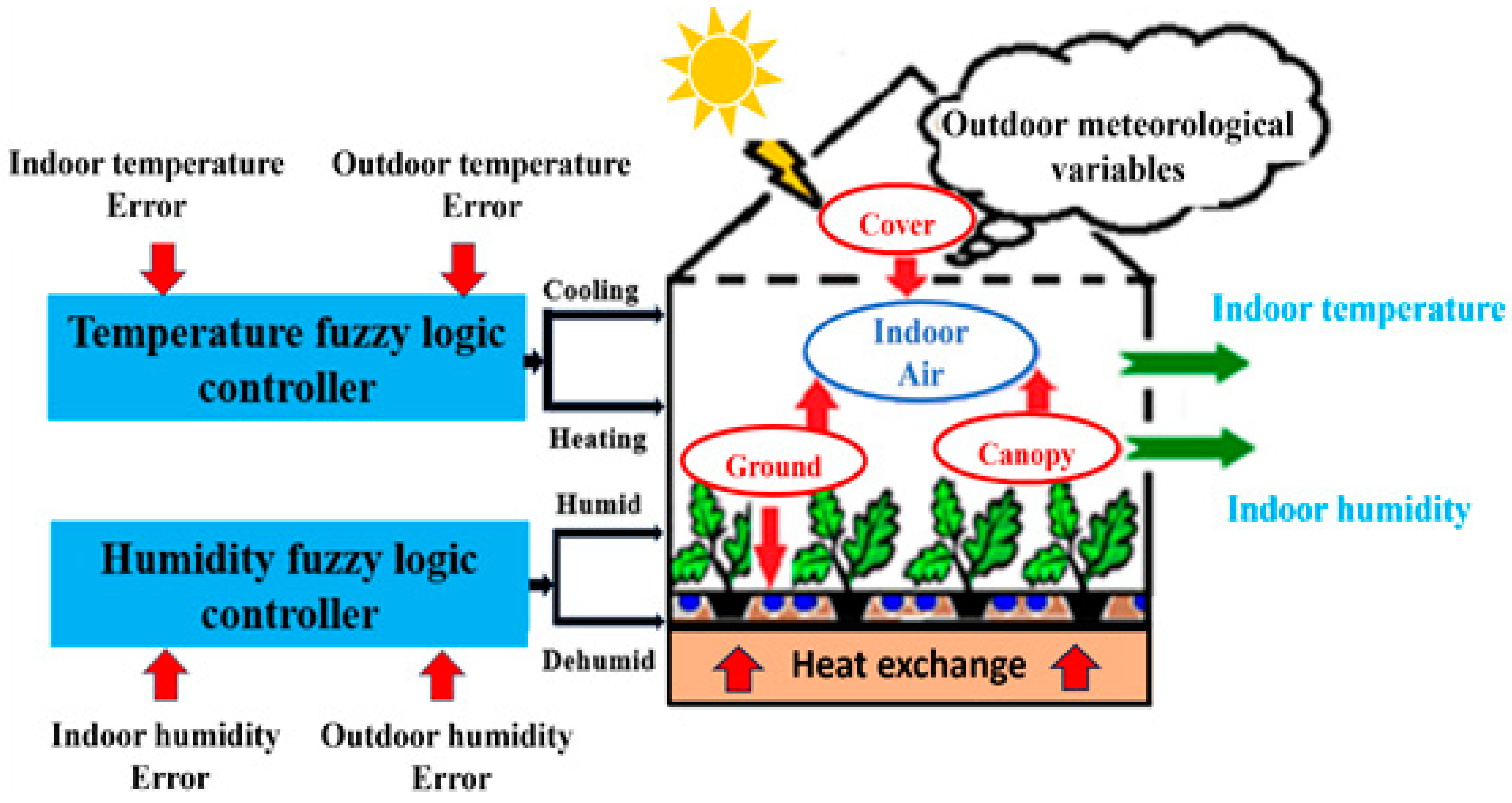
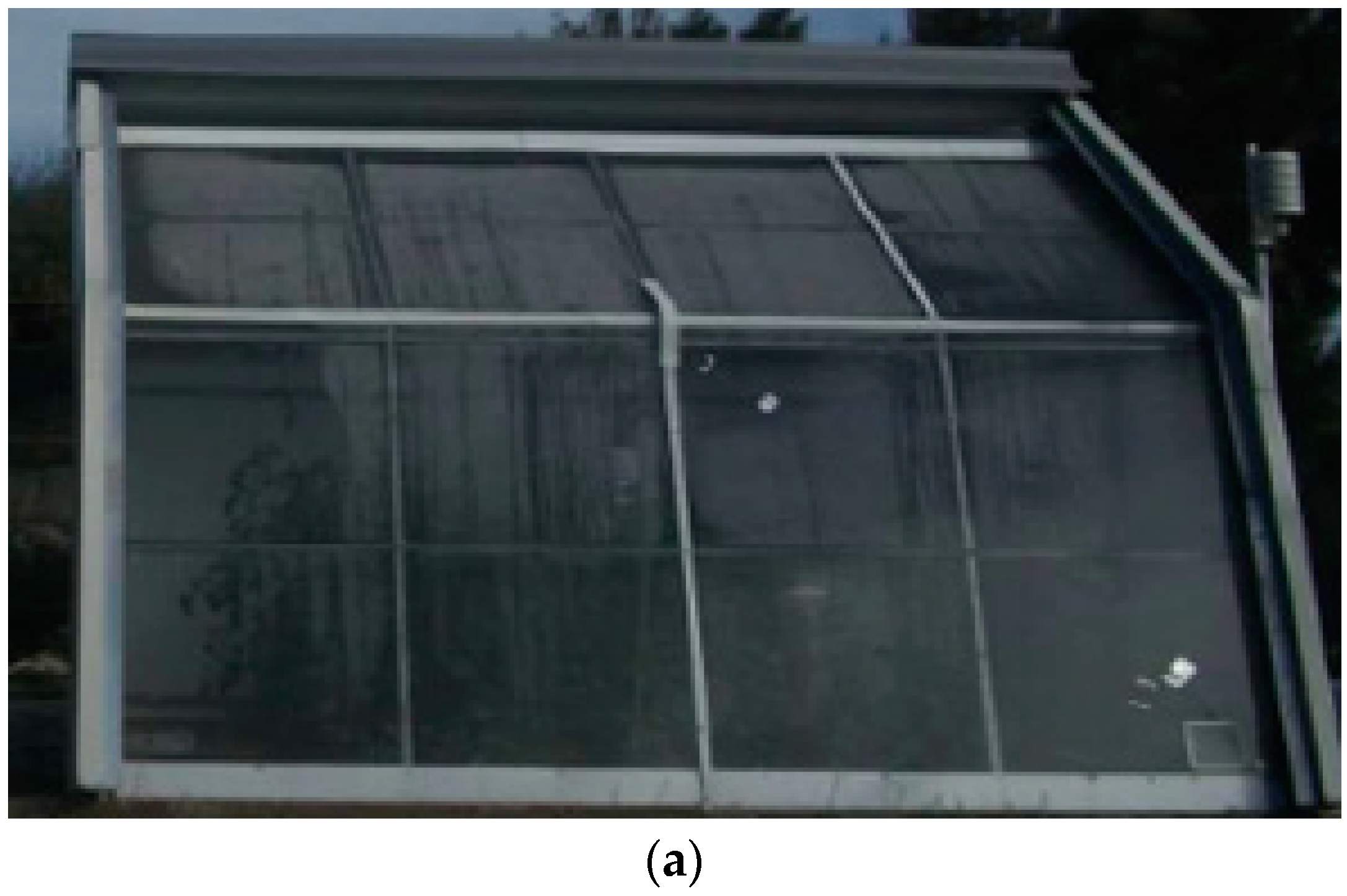
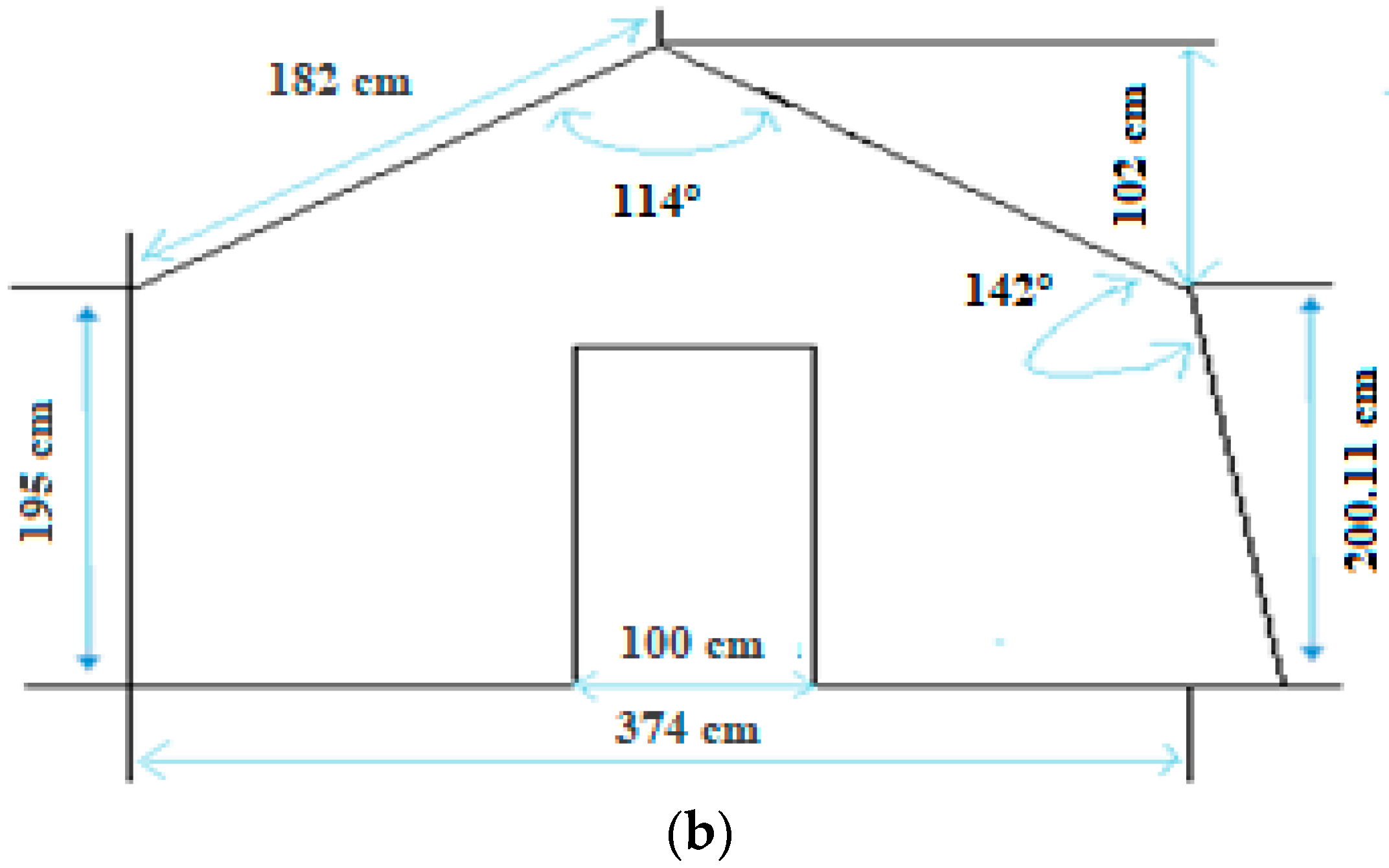





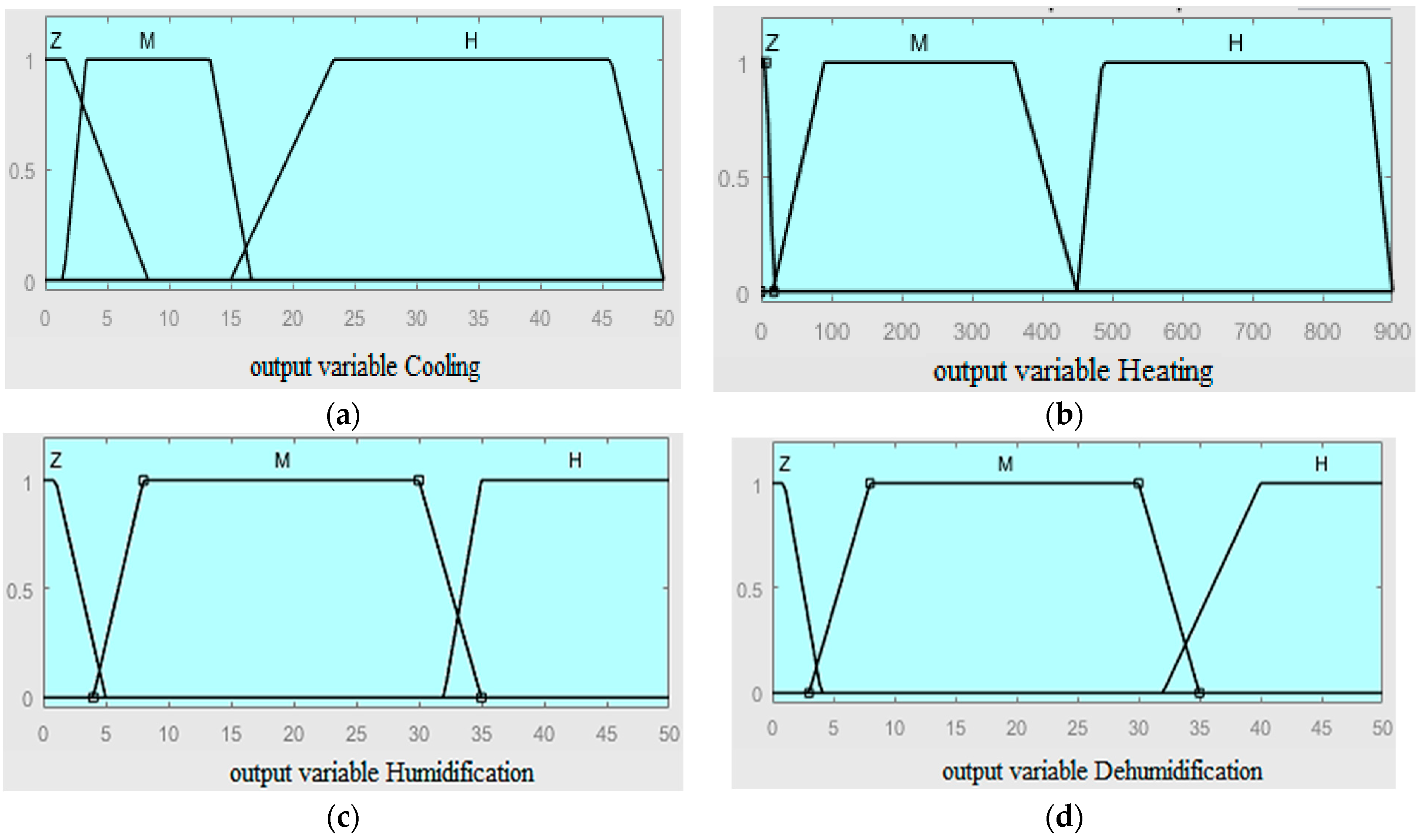
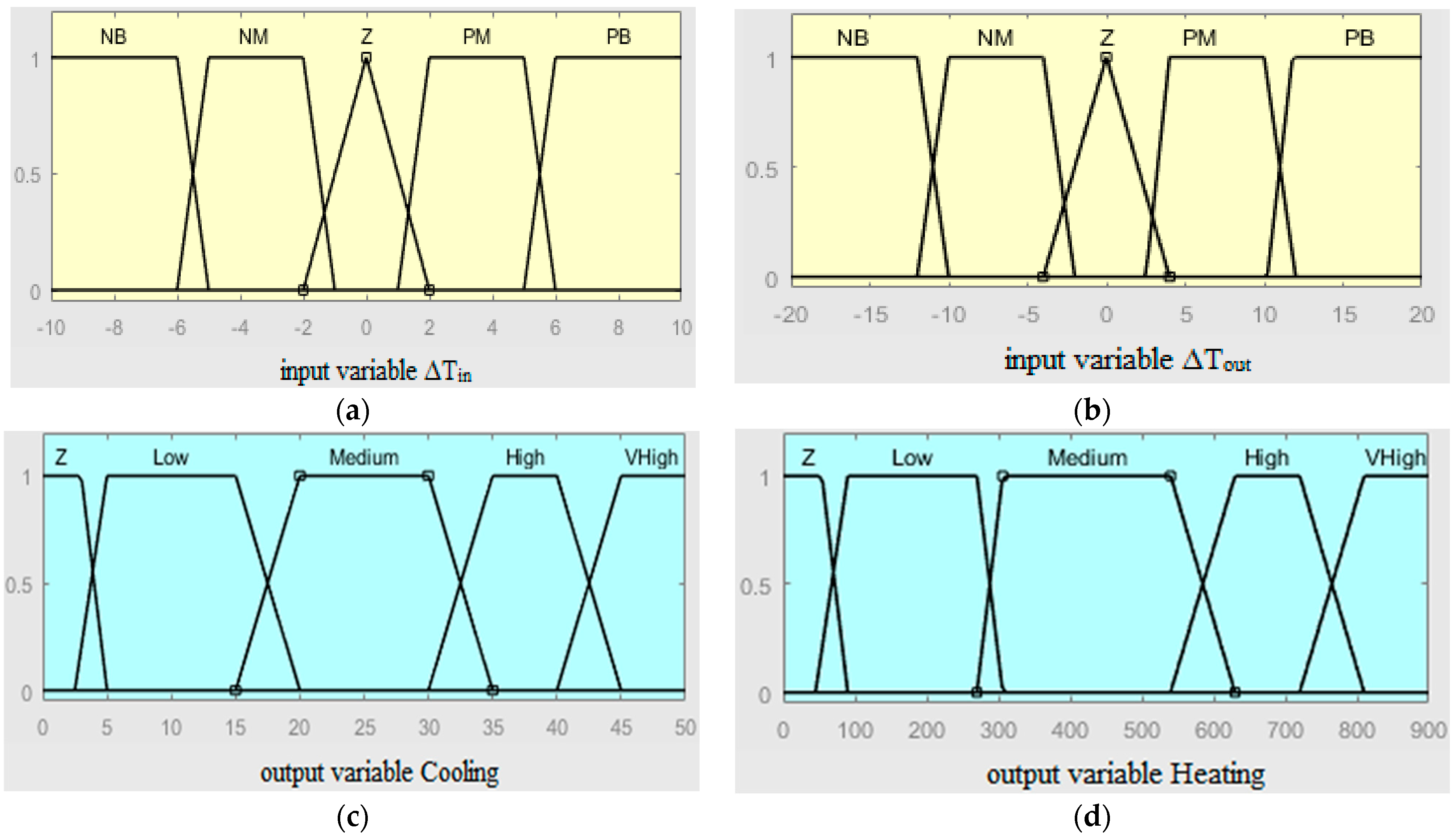
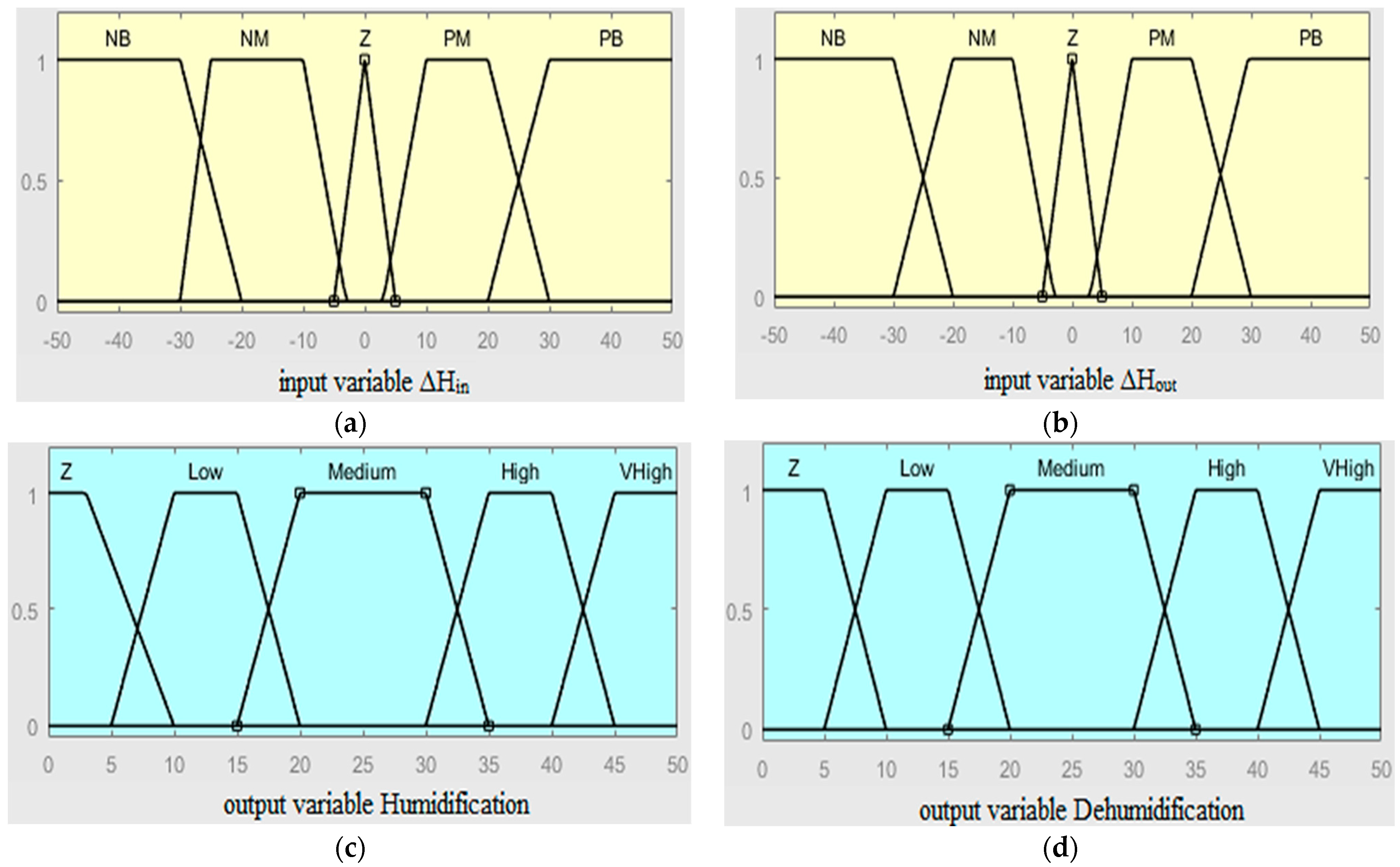
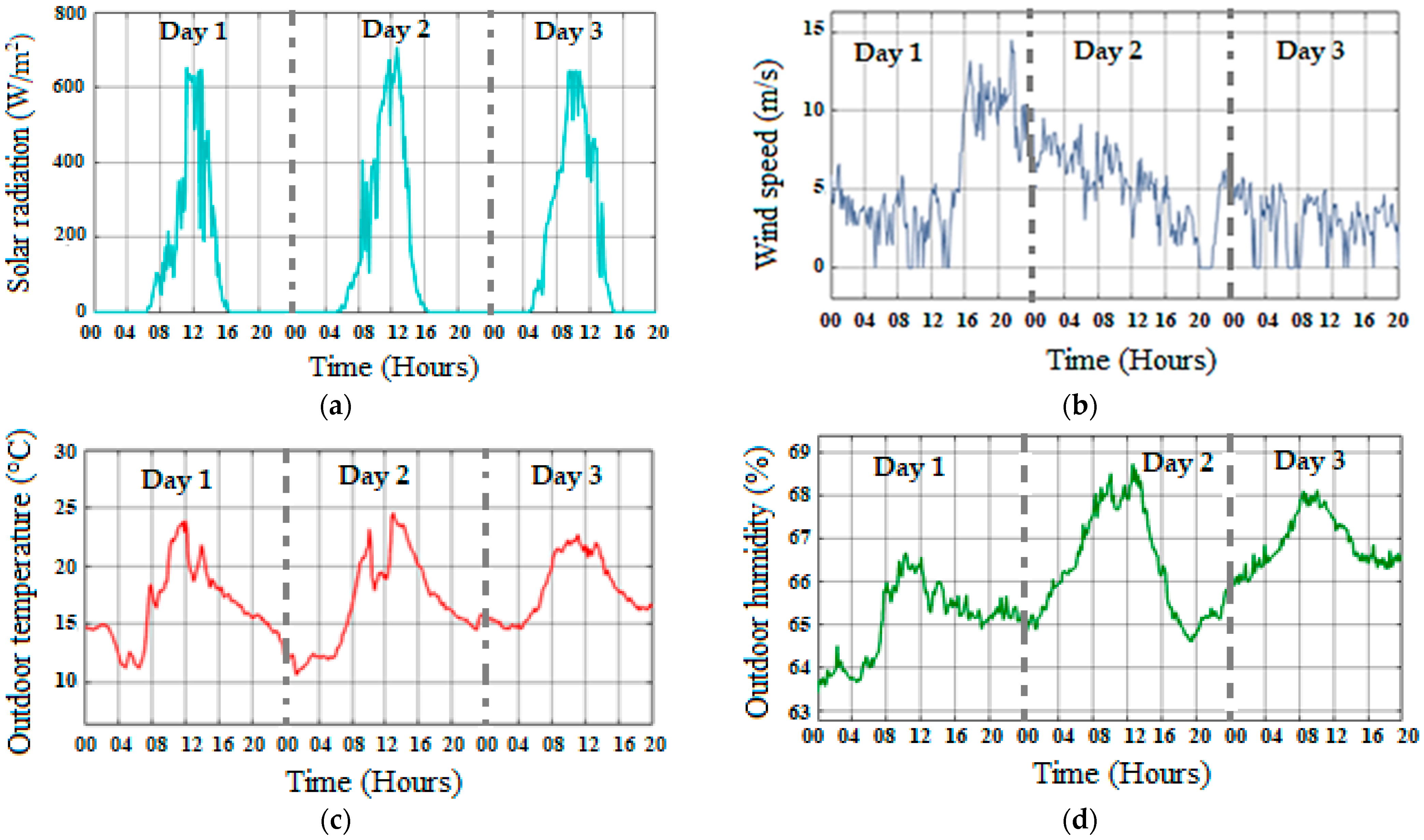
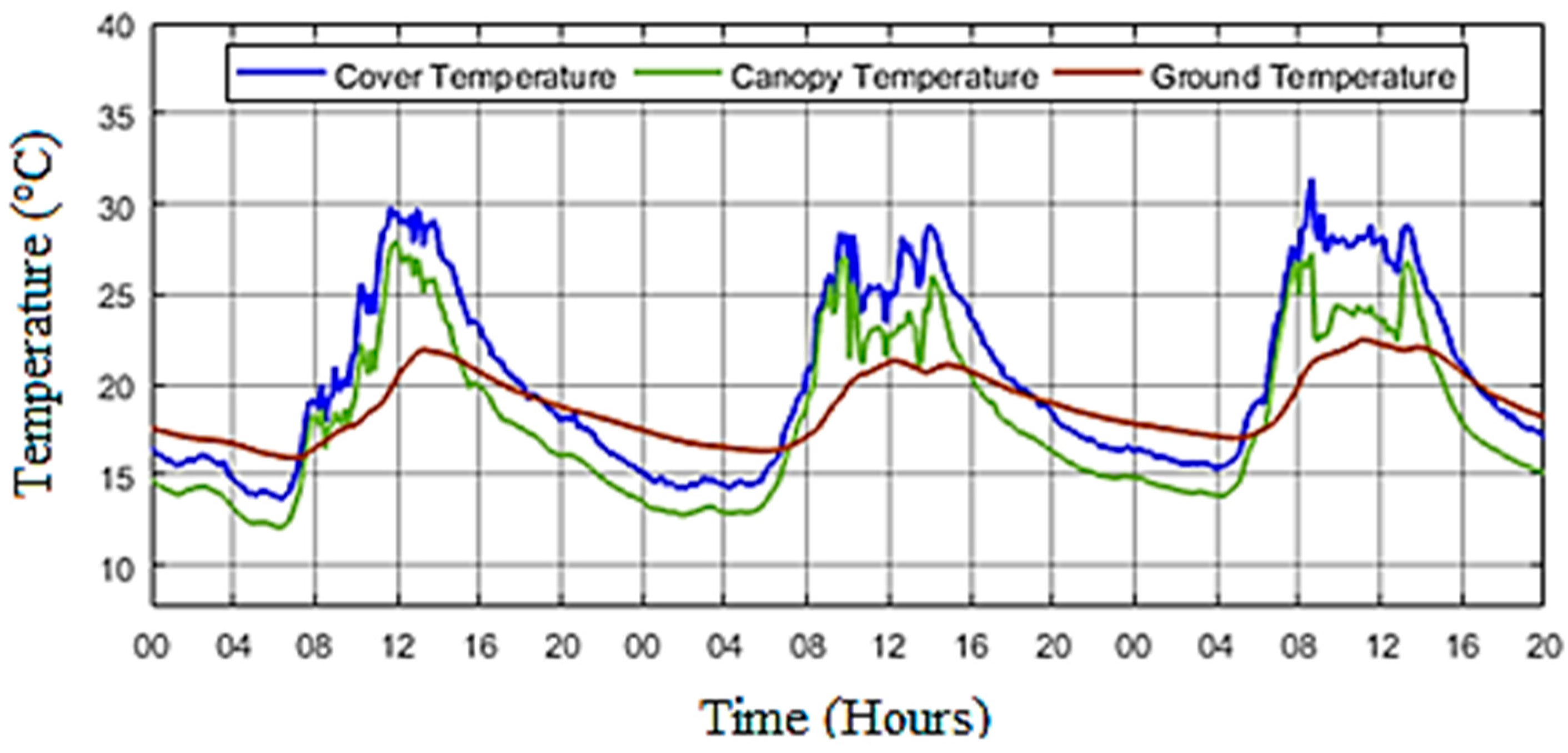
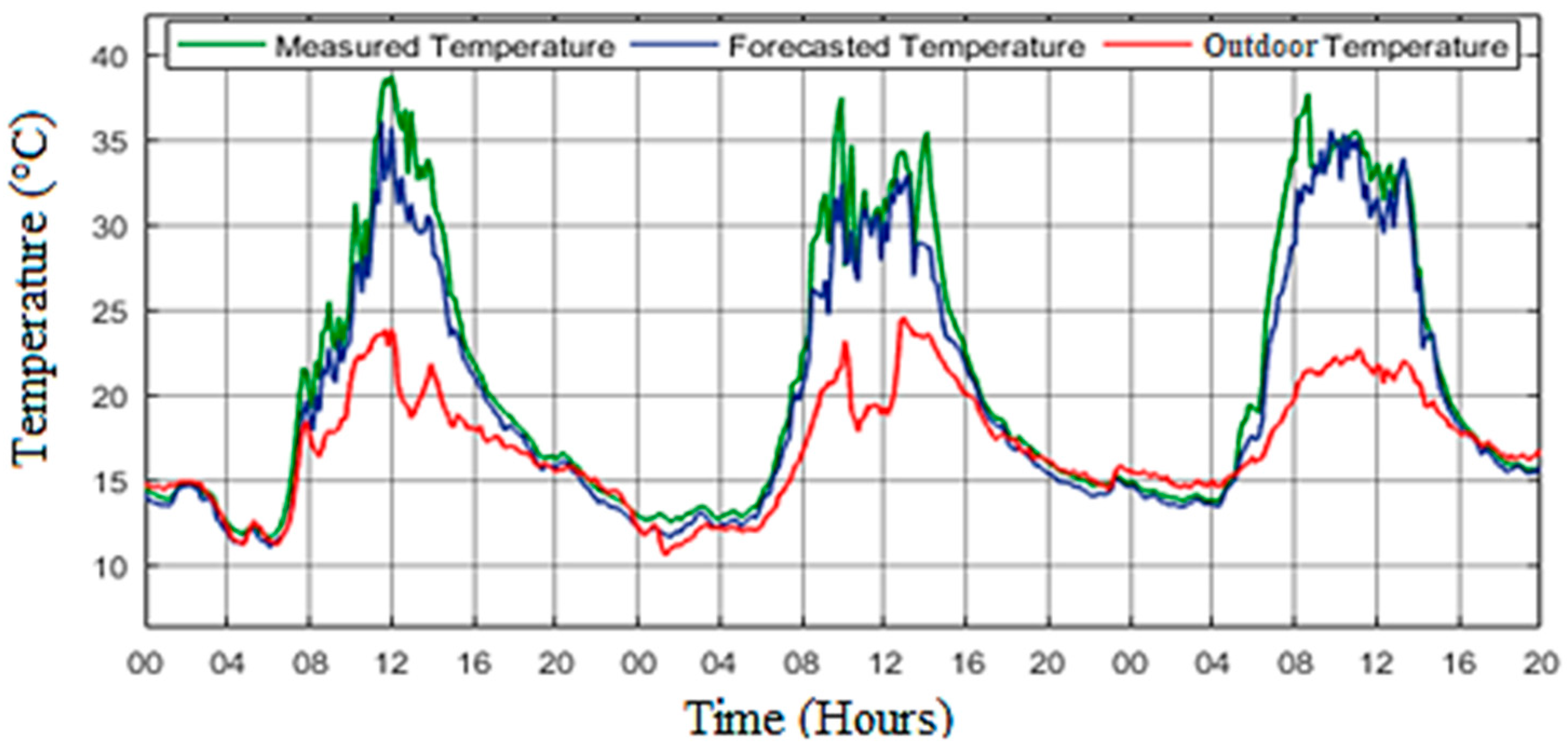
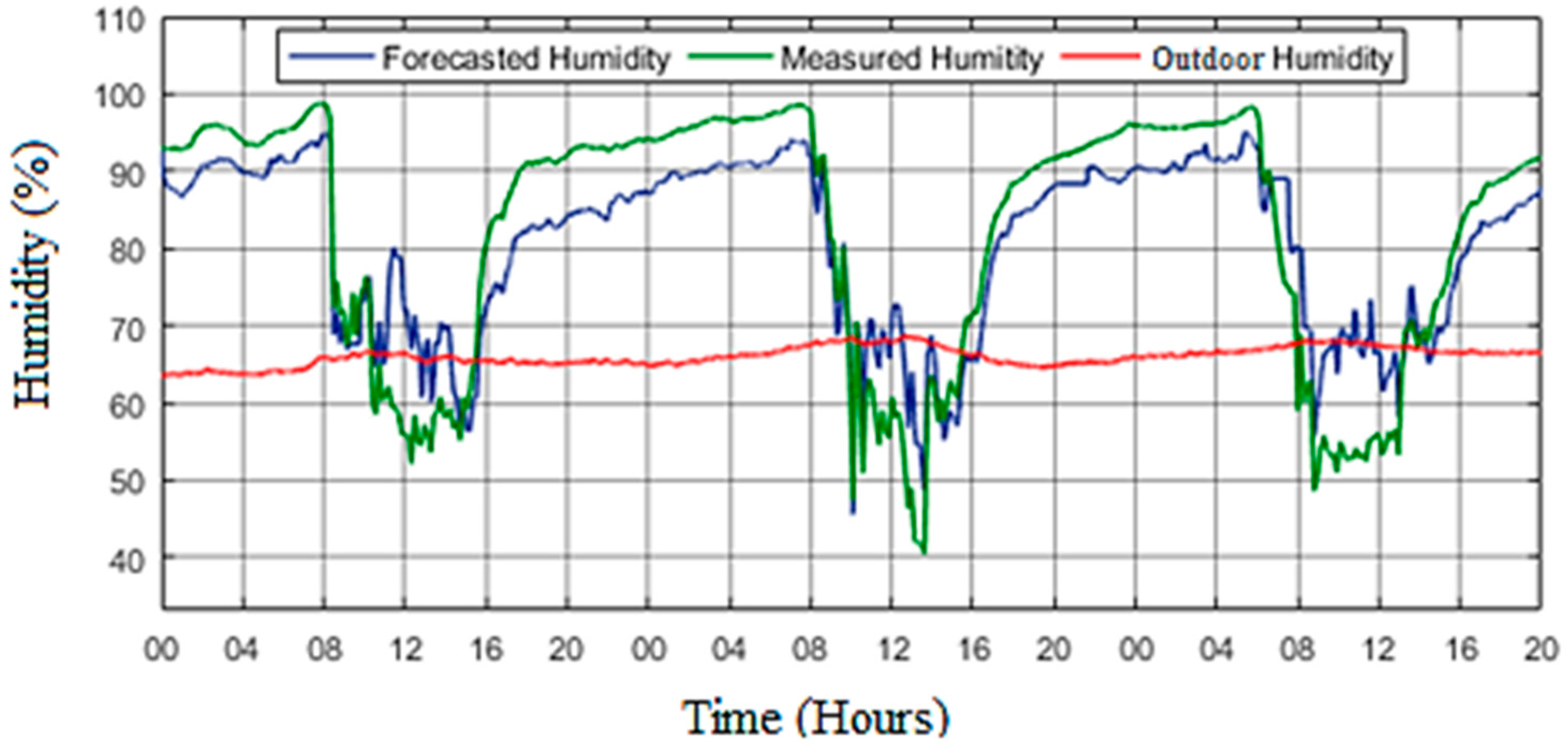

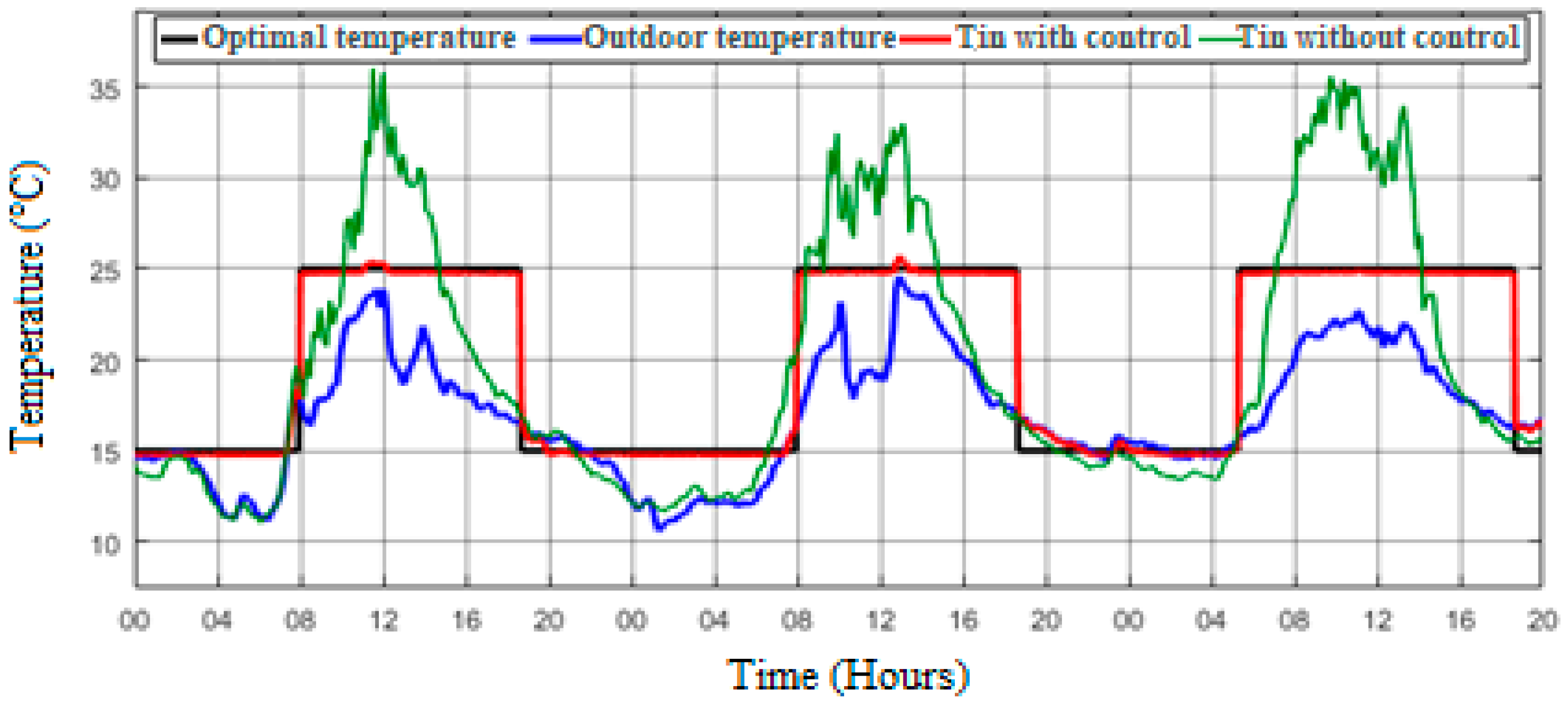
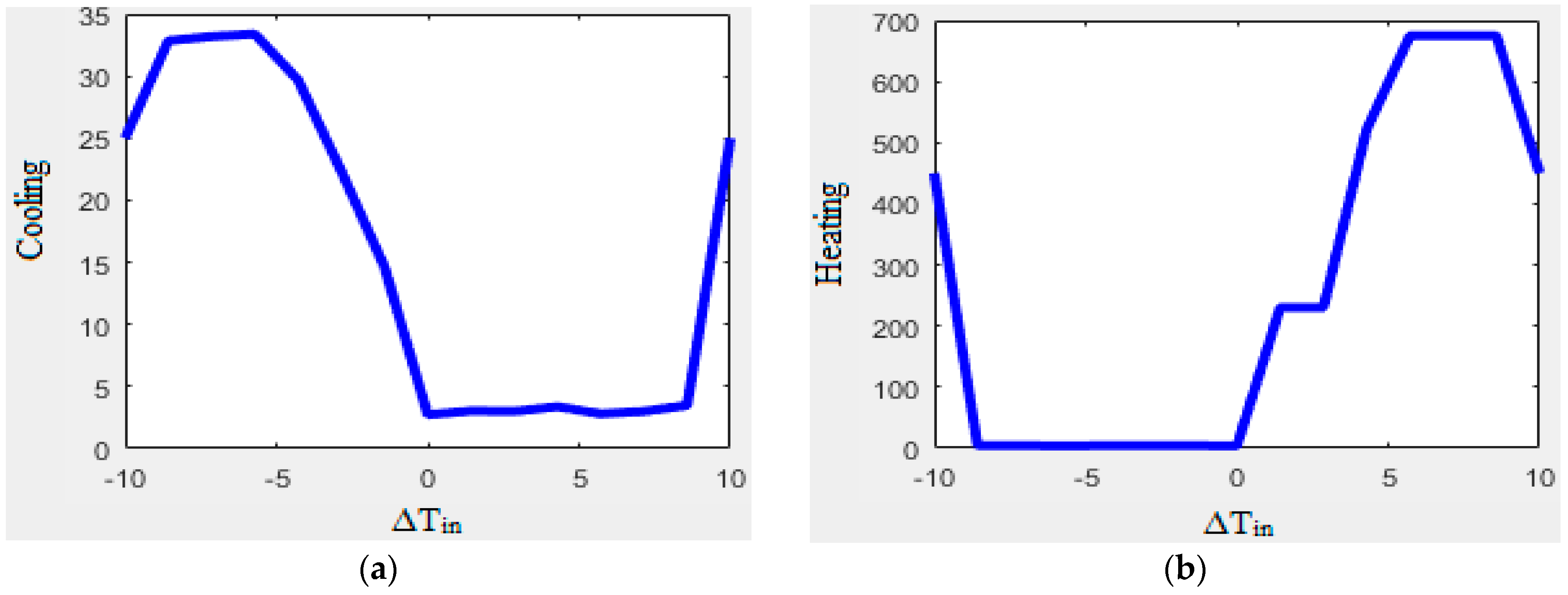



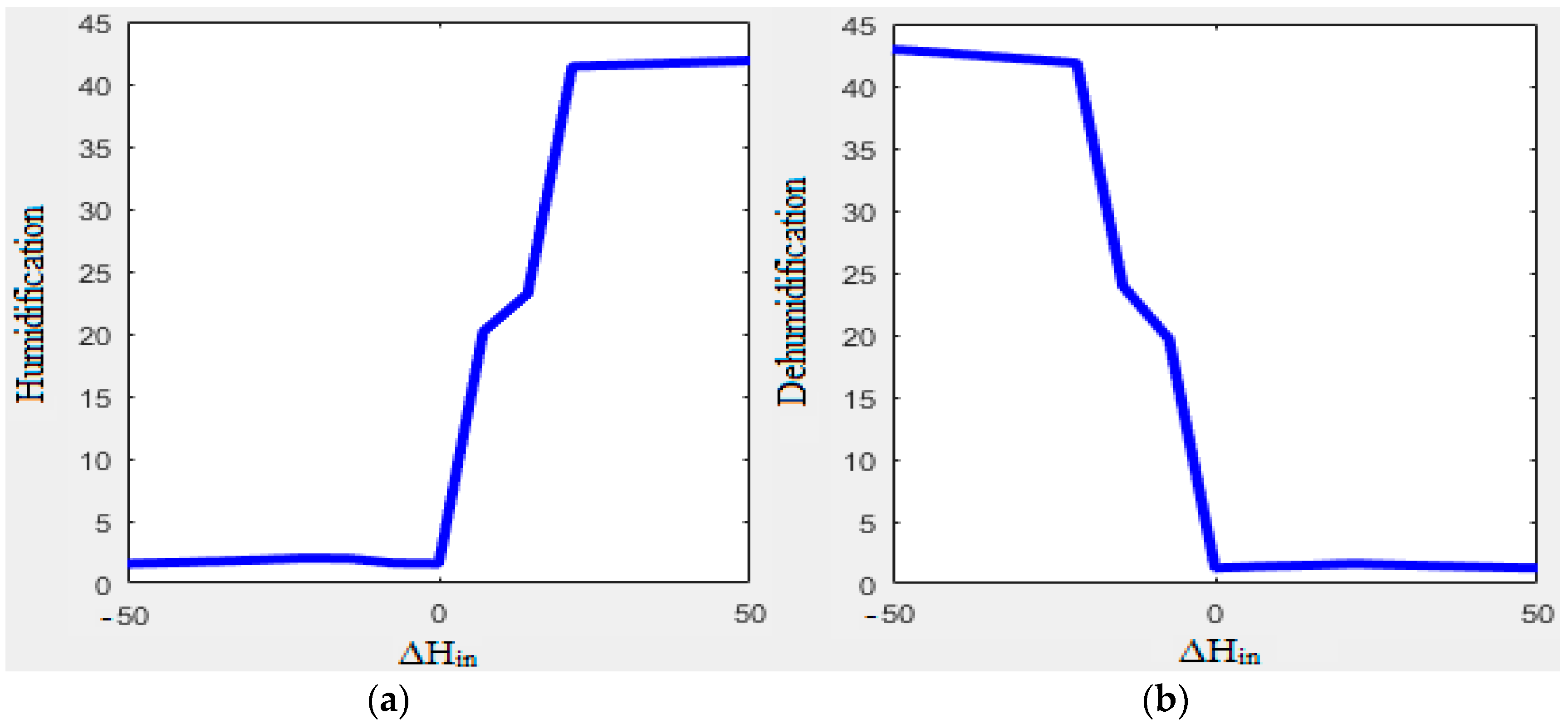


| Name | Equation | Abbreviation and Unit |
|---|---|---|
| Root mean squared error | RMSE | |
| Total sum of squared error | TSSE | |
| Mean absolute percentage error | MAPE | |
| Model efficiency factor | EF |
| Characteristics | Values (%) |
|---|---|
| Transmissivity for solar radiation | 0.85 |
| Reflectivity for solar radiation | 0.10 |
| Reflectivity for thermal radiation | 0.10 |
| Emissivity | 0.89 |
| Transmissivity for thermal radiation | 0.88 |
| ΔTin | Cooling (CO) | Heating (HE) |
|---|---|---|
| NB | High | Zero |
| NM | Medium | Zero |
| Z | Zero | Zero |
| PM | Zero | Medium |
| PB | Zero | High |
| ΔHin | Humidification (HU) | Dehumidification (DH) |
|---|---|---|
| NB | Zero | High |
| NM | Zero | Medium |
| Z | Zero | Zero |
| PM | Medium | Zero |
| PB | High | Zero |
| ΔTin ΔTout | NB | NM | Z | PM | PB |
|---|---|---|---|---|---|
| NB | HE(VHigh) | HE(High) | HE(Medium) | HE(Low) | HE(Z) |
| NM | HE(High) | HE(Medium) | HE(Low) | HE(Z) | C(Z) |
| Z | HE(Medium) | HE(Low) | HE(Z) | C(Low) | C(Medium) |
| PM | HE(Low) | HE(Z) | C(Low) | C(Medium) | C(High) |
| PB | HE(Z) | C(Z) | C(Medium) | C(VHigh) | C(VHigh) |
| ΔHin ΔHout | NB | NM | Z | PM | PB |
|---|---|---|---|---|---|
| NB | H(VHigh) | H(High) | H(Medium) | H(Low) | H(Z) |
| NM | H(High) | H(Medium) | H(Low) | H(Z) | DH(Z) |
| Z | H(Medium) | H(Low) | H(Z) | DH(Low) | DH(Medium) |
| PM | H(Low) | H(Z) | DH(Low) | DH(Medium) | DH(High) |
| PB | H(Z) | DH(Medium) | DH(High) | DH(VHigh) | DH(VHigh) |
| Climatic Variables | RMSE | TSSE | MAPE (%) | EF (%) |
|---|---|---|---|---|
| Air temperature | 0.017 °C | 1.36 °C | 0.022 | 98.29 |
| Relative humidity | 0.071% | 1.29% | 0.026 | 90.98 |
| Fuzzy Logic Controllers | RMSE (%) | MAPE (%) | EF (%) | |
|---|---|---|---|---|
| FLC-I | Temperature | 1.87 | 6.04 | 85.40 |
| Humidity | 0.24 | 0.61 | 99.34 | |
| FLC-II | Temperature | 0.69 | 1.84 | 99.35 |
| Humidity | 0.23 | 0.17 | 99.86 |
| Methods | RMSE (T) | EF (T) | RMSE (H) | EF (H) |
|---|---|---|---|---|
| Proposed model prediction | 0.017 | 98.29 | 0.071 | 90.98 |
| Proposed FLC-II control efficacy | 0.69 | 99.35 | 0.23 | 99.86 |
| Accuracy of the greenhouse model [47] | 1.94 | -- | 3.16 | -- |
| Predict the dynamic model of the greenhouse [49] | 0.17 | 57.8 | 0.07 | 99.8 |
| Neural network predicting model [4] | 0.271 | -- | 0.481 | -- |
| Predicting model based on intelligence artificial [50] | 0.82 | -- | -- | -- |
| Data-driven robust model predictive control for temperature control [51] | 0.32 (0.60) | -- | -- | -- |
| Threshold control [52] | 1.19 | -- | 1.14 | -- |
| Model predictive control For one second [52] | 0.28 | -- | 0.15 | -- |
| PI controller [53] | 1.59 | -- | -- | -- |
| Model predictive control (MPC) [54] | 3.01 2.45 | -- | -- | -- |
Disclaimer/Publisher’s Note: The statements, opinions and data contained in all publications are solely those of the individual author(s) and contributor(s) and not of MDPI and/or the editor(s). MDPI and/or the editor(s) disclaim responsibility for any injury to people or property resulting from any ideas, methods, instructions or products referred to in the content. |
© 2024 by the authors. Licensee MDPI, Basel, Switzerland. This article is an open access article distributed under the terms and conditions of the Creative Commons Attribution (CC BY) license (https://creativecommons.org/licenses/by/4.0/).
Share and Cite
Riahi, J.; Nasri, H.; Mami, A.; Vergura, S. Effectiveness of the Fuzzy Logic Control to Manage the Microclimate Inside a Smart Insulated Greenhouse. Smart Cities 2024, 7, 1304-1329. https://doi.org/10.3390/smartcities7030055
Riahi J, Nasri H, Mami A, Vergura S. Effectiveness of the Fuzzy Logic Control to Manage the Microclimate Inside a Smart Insulated Greenhouse. Smart Cities. 2024; 7(3):1304-1329. https://doi.org/10.3390/smartcities7030055
Chicago/Turabian StyleRiahi, Jamel, Hamza Nasri, Abdelkader Mami, and Silvano Vergura. 2024. "Effectiveness of the Fuzzy Logic Control to Manage the Microclimate Inside a Smart Insulated Greenhouse" Smart Cities 7, no. 3: 1304-1329. https://doi.org/10.3390/smartcities7030055
APA StyleRiahi, J., Nasri, H., Mami, A., & Vergura, S. (2024). Effectiveness of the Fuzzy Logic Control to Manage the Microclimate Inside a Smart Insulated Greenhouse. Smart Cities, 7(3), 1304-1329. https://doi.org/10.3390/smartcities7030055







